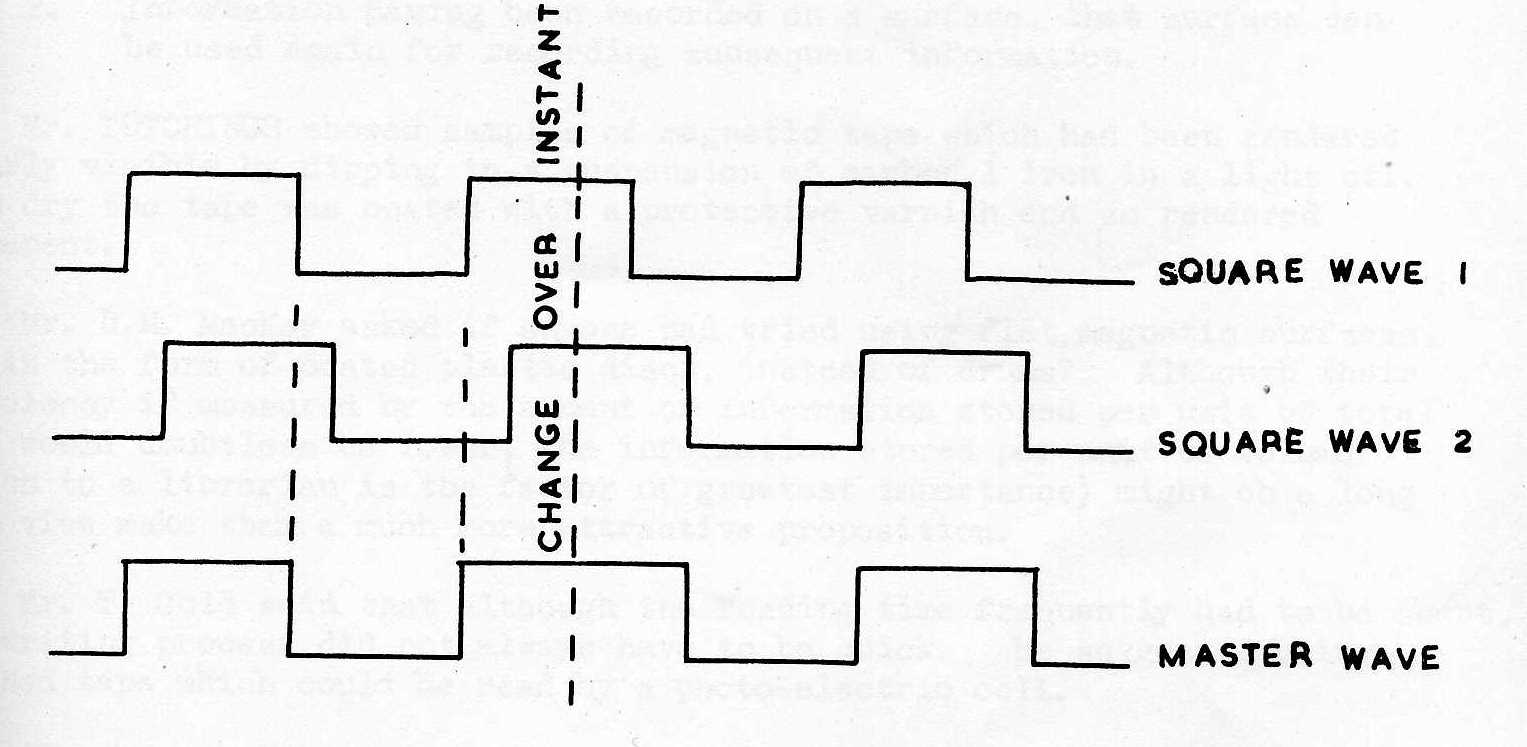

Mr D.W. Willis continued the discussion by making the following remarks on A Proposed Magnetic Wire Auxillary Store for the EDSAC.
It is relevant to contrast what has been said about magnetic drum storage with the wire system at present being considered as an auxiliary store for the EDSAC. The information will be transferred to and from the main high-speed store in blocks, and the wire must stop and start between each reading or writing operation. We cannot depend on constant wire speed, nor can we strobe the output against clock pulses since the wire has only one track. A three-state system is therefore required, positive and negative pulses and blank wire, each pulse being decoded as it arrives. This is done by gating the delayed positive half of a pulse with the negative half reversed, and necessitates leaving a blank space of one half pulse length between pulses.
The storage wire to be used is nickel-coated bronze wire .0045 inches thick. The wire is unwound from one and wound on to the other of two servo-controlled differentially-coupled coaxial drums, passing intermediately in contact with the reading and writing heads. These are each made of a quarter-inch circuit of permalloy with a small gap, wound astatically with eight turns of silk-covered wire. The whole is embedded in wax, between brass supporting blocks. Taking into account the spacing between pulses, the overall packing density will be about 60 per inch.
It is a fundamental requirement of every form of storage that previous information be erased from a given location as new material is written. In synchronous drum systems, writing is carried to saturation and new material is overprinted on the old. In an asynchronous system, a separate erasing head is required, and it is not necessary to write to saturation. Erasing can be achieved by two methods, neither of which have yet been put into operation. The wire can be passed through an alternating field generated over a comparatively large region such that a given element of wire is withdrawn from a saturating field in several hundred cycles. Alternatively the wire may be magnetised to saturation transversely by running it between the pole-pieces of an electromagnet. Of these the second method seems the more attractive.
In reply to Mr. K.E, MACHIN, Mr. Willis said that a greater capacity could be obtained by using wire than by using a drum.
Dr. UTTLEY made the following remarks about the work at T.R.E.
The use of a drum coated with magnetic iron oxide has made it possible to achieve at T.T.E. a density of over 6,000 digits per square inch.
When one has the choice of synchronization of electronic wave-forms to a mechanical rotation or conversely of synchronizing a mechanical rotation to an electrical waveform, then the former should be the correct choice. At Manchester and T.R.E, both alternatives are possible. It has been said that the former method does not allow of the use of interchangeable drums, but it can be shown that this is not so.
Consider two drums each with a master clock track capable of timing the electronic rhythm. Let each track produce a timing square wave of slightly different frequency and hence of slightly different phase relationship; let the computer be timed from the output of a trigger circuit capable of being set in its two states by positive and negative going edges (see Fig.2).
While the computer is under the control of Drum No.1 let the instruction be given - Change over to Drum No.2. The output of the trigger will then be as in waveform No.3 in Fig. 1. This will be quite acceptable to a computer which is aperiodic in nature.
(Note added Nov., 1949)- Since the conference it has been decided that first experimental auxiliary store for the EDSAC will use a magnetic drum. It is hoped to develop a system which uses magnetic wire later.


Dr. Uttley went on to describe some preliminary experiments in electrostatic photography. A metal plate had been coated with sulphur which is highly insulating when dark. The surface of the sulphur was given an electrostatic charge. The plate was dusted with an insulating powder, and exposed behind a negative of simple pattern. The parts of the plate which had been exposed to light rendered the sulphur relatively conducting so that the charge leaked away and the powder fell off in a current of air. The picture could be fixed by varnishing.
The advantages of this system over normal photography might be:
Mr. TUTCHINGS showed samples of magnetic tape which had been rendered clearly visible by dipping in a suspension of carbonyl iron in a light oil. When dry the tape was coated with a protective varnish and so rendered permanent.
Mr. D.M. MacKay asked if anyone had tried using flat magnetic surfaces, say in the form of coated plastic discs, instead of drums? Although their efficiency if measured by the amount of information stored per unit of total area would doubtless be lower, the information stored per unit of volume (which to a librarian is the factor of greatest importance) might on a long term view make them a much more attractive proposition.
Mr. T. Gold said that although the reading time frequently had to be short, the writing process did not always have to be quick. He suggested using punched tape which could be read by a photo-electric cell.